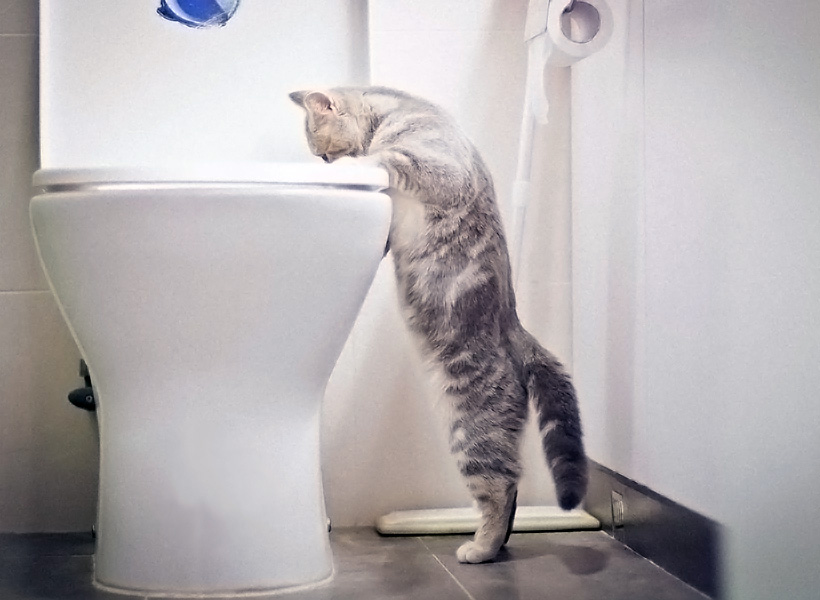Prevent Clogs and Damage: Never Flush Cat Poop Down Your Toilet - Professional Recommendations
Prevent Clogs and Damage: Never Flush Cat Poop Down Your Toilet - Professional Recommendations
Blog Article
What are your insights and beliefs on How to Dispose of Cat Poop and Litter Without Plastic Bags?

Intro
As cat owners, it's important to be mindful of just how we take care of our feline pals' waste. While it may appear hassle-free to flush pet cat poop down the bathroom, this technique can have harmful effects for both the environment and human health and wellness.
Environmental Impact
Flushing feline poop presents dangerous pathogens and parasites into the supply of water, posturing a substantial risk to aquatic ecosystems. These impurities can adversely influence aquatic life and concession water top quality.
Health Risks
Along with environmental worries, flushing pet cat waste can additionally present health and wellness threats to humans. Pet cat feces might contain Toxoplasma gondii, a bloodsucker that can create toxoplasmosis-- a potentially serious disease, particularly for expecting females and individuals with weakened immune systems.
Alternatives to Flushing
The good news is, there are much safer and extra accountable means to take care of feline poop. Consider the adhering to alternatives:
1. Scoop and Dispose in Trash
One of the most typical technique of dealing with feline poop is to scoop it into a naturally degradable bag and throw it in the trash. Make certain to utilize a devoted litter scoop and take care of the waste without delay.
2. Usage Biodegradable Litter
Choose naturally degradable feline trash made from materials such as corn or wheat. These trashes are eco-friendly and can be safely gotten rid of in the trash.
3. Hide in the Yard
If you have a yard, take into consideration burying feline waste in an assigned area away from veggie gardens and water resources. Make sure to dig deep enough to prevent contamination of groundwater.
4. Set Up a Pet Waste Disposal System
Invest in a pet dog waste disposal system especially designed for feline waste. These systems use enzymes to break down the waste, minimizing smell and environmental influence.
Final thought
Liable family pet possession extends beyond giving food and shelter-- it likewise involves correct waste management. By avoiding purging feline poop down the commode and choosing alternate disposal approaches, we can reduce our ecological impact and safeguard human wellness.
Why Can’t I Flush Cat Poop?
It Spreads a Parasite
Cats are frequently infected with a parasite called toxoplasma gondii. The parasite causes an infection called toxoplasmosis. It is usually harmless to cats. The parasite only uses cat poop as a host for its eggs. Otherwise, the cat’s immune system usually keeps the infection at low enough levels to maintain its own health. But it does not stop the develop of eggs. These eggs are tiny and surprisingly tough. They may survive for a year before they begin to grow. But that’s the problem.
Our wastewater system is not designed to deal with toxoplasmosis eggs. Instead, most eggs will flush from your toilet into sewers and wastewater management plants. After the sewage is treated for many other harmful things in it, it is typically released into local rivers, lakes, or oceans. Here, the toxoplasmosis eggs can find new hosts, including starfish, crabs, otters, and many other wildlife. For many, this is a significant risk to their health. Toxoplasmosis can also end up infecting water sources that are important for agriculture, which means our deer, pigs, and sheep can get infected too.
Is There Risk to Humans?
There can be a risk to human life from flushing cat poop down the toilet. If you do so, the parasites from your cat’s poop can end up in shellfish, game animals, or livestock. If this meat is then served raw or undercooked, the people who eat it can get sick.
In fact, according to the CDC, 40 million people in the United States are infected with toxoplasma gondii. They get it from exposure to infected seafood, or from some kind of cat poop contamination, like drinking from a stream that is contaminated or touching anything that has come into contact with cat poop. That includes just cleaning a cat litter box.
Most people who get infected with these parasites will not develop any symptoms. However, for pregnant women or for those with compromised immune systems, the parasite can cause severe health problems.
How to Handle Cat Poop
The best way to handle cat poop is actually to clean the box more often. The eggs that the parasite sheds will not become active until one to five days after the cat poops. That means that if you clean daily, you’re much less likely to come into direct contact with infectious eggs.
That said, always dispose of cat poop in the garbage and not down the toilet. Wash your hands before and after you clean the litter box, and bring the bag of poop right outside to your garbage bins.
https://trenchlesssolutionsusa.com/why-cant-i-flush-cat-poop/

Do you like reading up on How to Dispose of Cat Poop and Litter Without Plastic Bags? Write feedback further down. We'd be glad to hear your insights about this page. We are looking forward that you visit us again in the future. Are you aware of anybody else who is curious about the subject? Why not share it. We love reading our article about Can You Flush Cat Poop Down The Toilet?.
Click Here Report this page